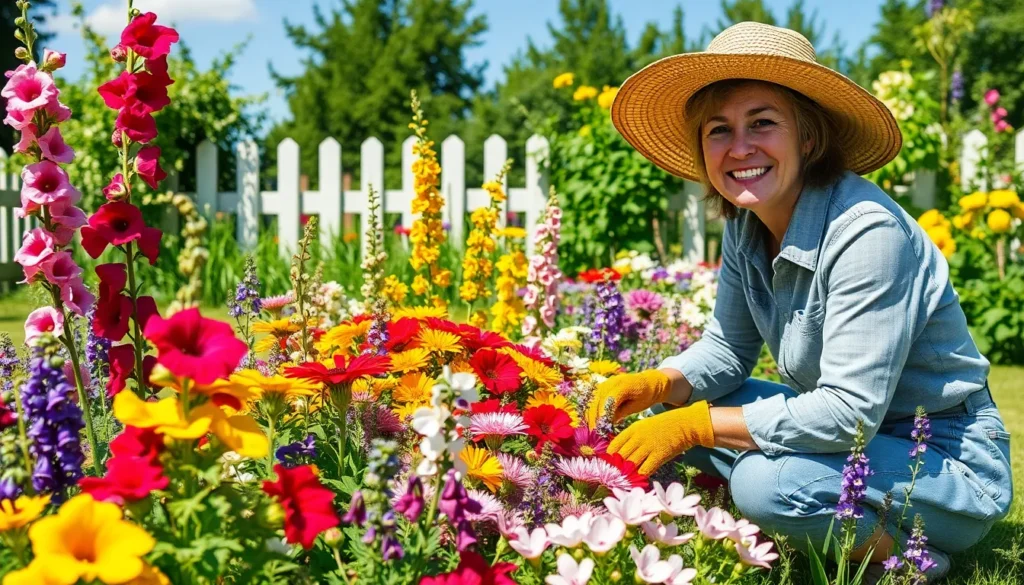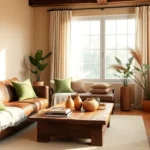We’ve all stood in our yards wondering how to transform that plain patch of grass into something spectacular. Creating beautiful flower beds doesn’t have to be overwhelming or expensive – it just takes the right inspiration and a solid plan.
Whether you’re working with a sprawling backyard or a cozy front entrance we’ll show you how to design stunning flower beds that’ll make your neighbors stop and stare. From choosing the perfect color combinations to selecting plants that thrive in your exact conditions these ideas will help you create outdoor spaces that bloom with personality.
The best part? Most of these flower bed designs can be accomplished in a weekend with materials you can find at any garden center. We’re about to jump into creative layouts budget-friendly options and professional tips that’ll have you designing like a industry expert in no time.
Create a Colorful Cottage Garden Flower Bed
We’ll transform your outdoor space into a charming cottage garden that captures the romantic, relaxed aesthetic of traditional English countryside gardens. This timeless style combines abundant blooms with informal planting patterns to create a welcoming sanctuary.
Choose Heritage Flowers and Heirloom Varieties
Heritage flowers bring authentic cottage garden charm with their proven performance and classic appeal. We recommend selecting hollyhocks, foxgloves, and sweet peas as your foundation plants since they’ve graced cottage gardens for centuries. These varieties offer superior disease resistance compared to modern hybrids while maintaining their original fragrance and natural beauty.
Heirloom roses like ‘Apothecary’s Rose’ and ‘Mme. Hardy’ provide exceptional bloom quality with intense fragrance that modern varieties often lack. We suggest planting delphinium, larkspur, and Canterbury bells to add vertical interest with their towering spikes of blue, pink, and white flowers. Old fashioned peonies create stunning focal points when planted in groups of three or five, producing massive blooms that return reliably each spring.
Cottage pinks and sweet william offer compact options for border edges while delivering the spicy fragrance that defines traditional cottage gardens. We’ve found that bachelor buttons, calendula, and nigella self seed readily, creating the spontaneous look that makes cottage gardens so appealing.
Mix Annuals and Perennials for Year-Round Interest
Annuals provide instant color and fill gaps while perennials establish their root systems during the first season. We balance these plant types by using 60% perennials for structure and 40% annuals for continuous blooms throughout the growing season. This ratio ensures your cottage garden maintains interest from early spring through late fall.
Spring flowering perennials like primrose, bleeding heart, and columbine create early season color before annual flowers reach their peak. We plant cosmos, zinnias, and marigolds among established perennials to extend the blooming period well into autumn. Fast growing annuals like sunflowers and cleome add dramatic height while slower perennials like peonies and delphiniums develop their mature form.
Summer combinations work best when we pair long blooming perennials such as catmint and salvia with heat tolerant annuals like vinca and portulaca. Late season interest comes from perennial asters and mums combined with cool weather annuals including pansy and ornamental kale.
Add Climbing Roses and Flowering Vines
Climbing roses create the quintessential cottage garden backdrop when trained on arbors, fences, or pergolas. We recommend ‘Eden’ and ‘New Dawn’ varieties for their repeat blooming habit and disease resistance in most climate zones. These roses provide vertical color while requiring minimal maintenance once established.
Clematis vines complement climbing roses perfectly when planted at their base, with the vine’s roots staying cool in the rose’s shade. We suggest pairing early blooming clematis varieties like ‘Nelly Moser’ with late season roses to extend the flowering period. Sweet peas trained on bamboo teepees add fragrance and cutting flowers throughout the summer months.
Morning glories and moonflowers offer rapid coverage for unsightly structures while providing daily flower shows. We plant honeysuckle and jasmine near seating areas where their evening fragrance can be fully appreciated. Grape vines serve dual purposes by creating shade overhead while producing edible fruit for cottage garden authenticity.
Design a Modern Minimalist Flower Bed
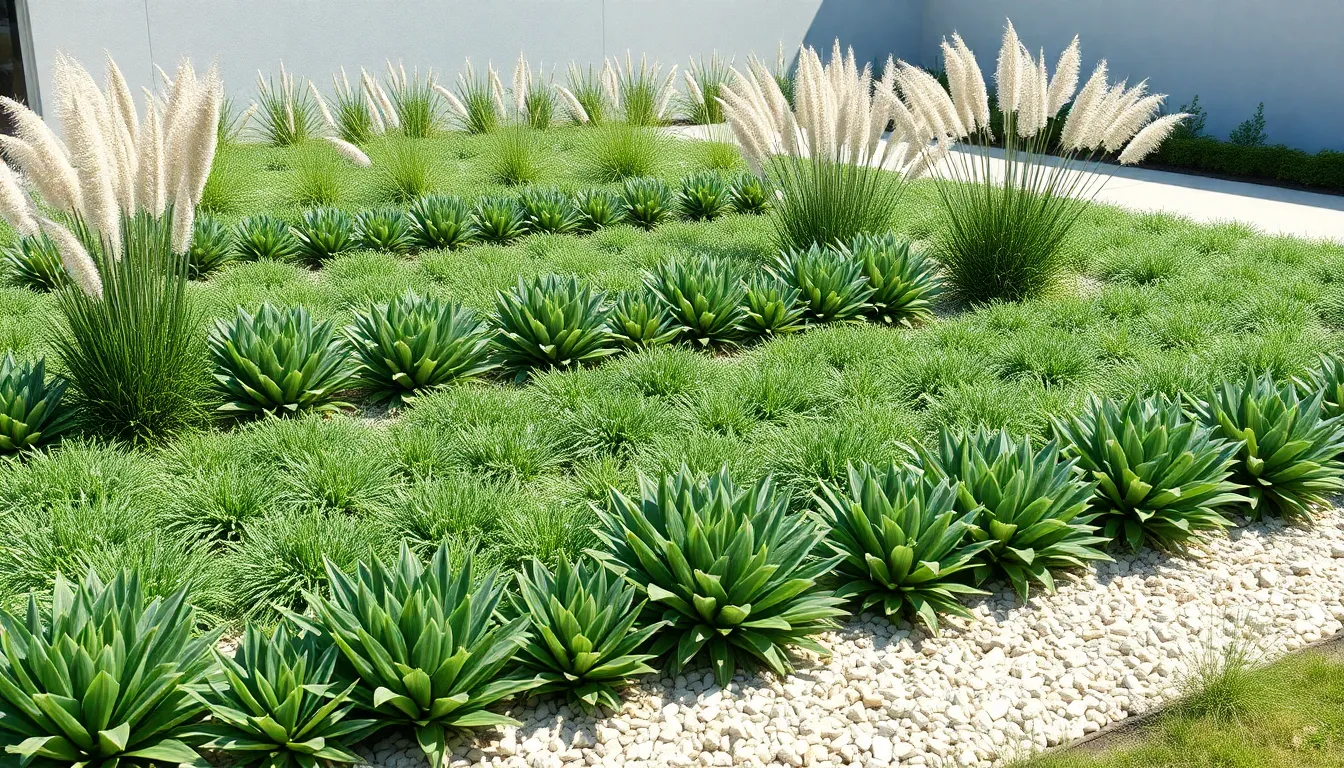
Clean lines and architectural elements create the foundation for stunning minimalist flower beds that serve as striking focal points. We’ll guide you through three essential design principles that transform ordinary garden spaces into sleek, contemporary displays.
Select a Monochromatic Color Scheme
Monochromatic palettes deliver powerful visual impact while maintaining the serene simplicity that defines minimalist design. We recommend choosing one primary color and exploring its various shades and tones throughout your flower bed. White gardens featuring hostas, white roses, and silver foliage plants create elegant sophistication, while purple schemes using lavender, alliums, and ornamental cabbage offer dramatic depth.
Limited color selections prevent visual chaos and allow individual plants to shine as design elements. Mulch becomes a crucial design tool in monochromatic beds, filling spaces between plants while maintaining the uncluttered aesthetic. We suggest using neutral mulches like light gravel or dark bark to complement your chosen color palette without competing for attention.
Use Geometric Planting Patterns
Geometric arrangements add architectural interest while reinforcing the minimalist philosophy of intentional design. We create visual rhythm by planting flowers in precise rows, squares, or triangular formations that echo modern industry architecture. Raised beds with geometric shapes like rectangles or circles provide structure and definition to your planting areas.
Repetition strengthens geometric impact, so we plant the same species in regular intervals to create patterns that guide the eye. Contrasting plant heights within geometric layouts add dimension while maintaining clean organization. Box hedging or low ornamental grasses work excellently as living borders that reinforce geometric shapes.
Incorporate Ornamental Grasses and Sculptural Plants
Ornamental grasses bring movement and texture to static minimalist designs while requiring minimal maintenance. We favor varieties like fountain grass, feather reed grass, and blue fescue for their graceful forms and seasonal interest. These grasses create ever-changing elements that sway with breezes, adding life to structured plantings.
Sculptural plants serve as living artwork within minimalist flower beds, providing focal points that anchor the entire design. We select plants with distinctive forms like architectural agave, spiky yucca, or rounded boxwood spheres that maintain their shape throughout seasons. Bold foliage plants like elephant ears or giant hosta varieties create dramatic statements without requiring colorful blooms.
Strategic placement of sculptural elements prevents monotony while respecting minimalist principles of restraint and intention. We position these statement plants at key viewing angles or intersection points within geometric layouts to maximize their visual impact.
Build a Raised Flower Bed for Better Drainage
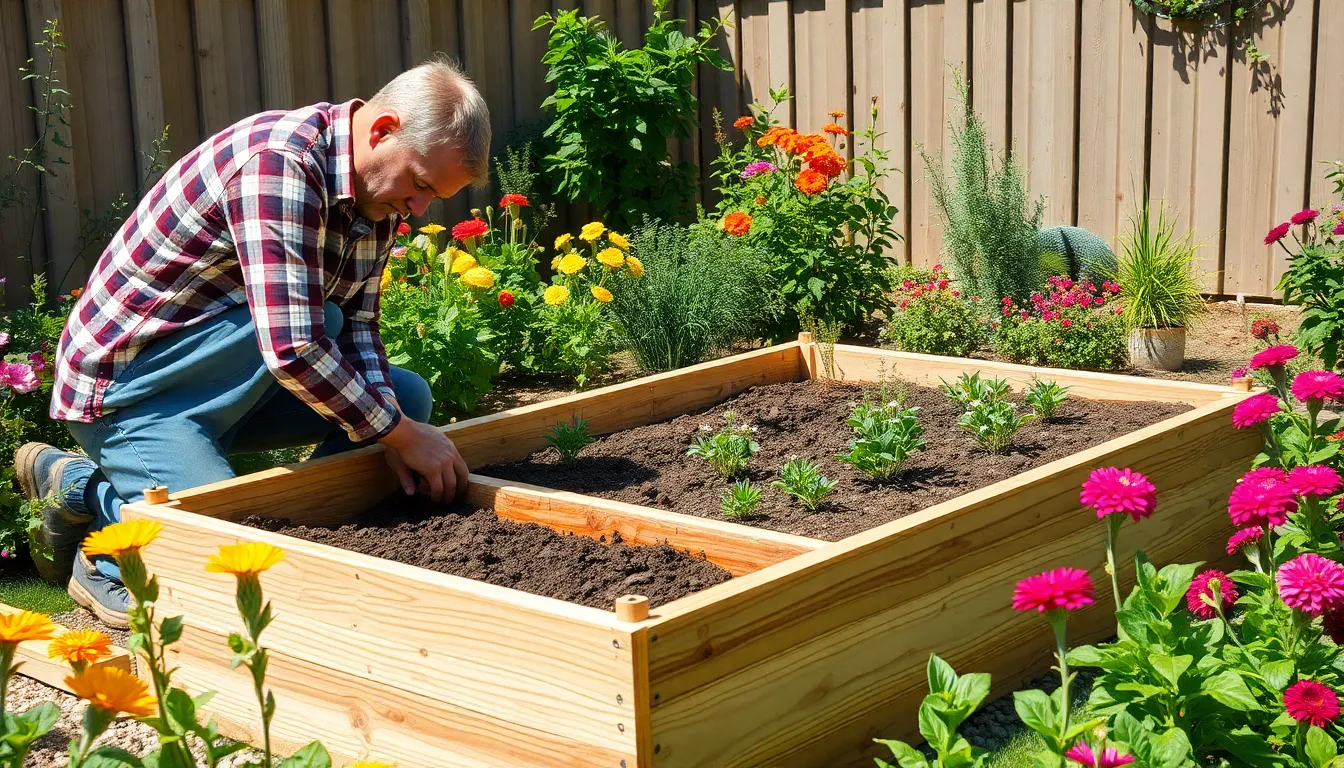
Creating raised flower beds transforms your garden’s drainage capabilities while adding structural beauty to your outdoor space. We’ll guide you through the essential steps to build a drainage-optimized raised bed that protects your plants from waterlogged soil.
Choose the Right Materials for Your Climate
Climate considerations should drive your material selection to ensure long-term durability and performance. Wood materials work beautifully in dry climates but can deteriorate quickly in moist environments where constant humidity accelerates rot and decay. Stone and brick materials offer superior weather resistance and can withstand extreme temperature fluctuations without warping or cracking.
Recycled plastic and composite materials provide excellent low-maintenance alternatives that resist moisture, insects, and UV damage. These modern options eliminate the need for annual treatments or replacements while maintaining their structural integrity across all climate zones. Brick materials enhance both durability and aesthetic appeal, creating timeless raised beds that complement traditional and contemporary garden designs.
Plan Proper Soil Depth and Composition
Soil depth requirements begin at 6-8 inches minimum to accommodate proper root development for most flowering plants. Deeper beds measuring 12-18 inches allow for larger perennials and provide better moisture retention during dry periods. Shallow rooted annuals thrive in the minimum depth while deep rooted plants like roses and ornamental grasses benefit from the additional soil volume.
Soil composition mixing combines three essential components for optimal plant health and drainage performance:
| Component | Percentage | Purpose |
|---|---|---|
| Quality topsoil | 50-60% | Provides nutrients and structure |
| Aged compost | 30-40% | Improves fertility and water retention |
| Perlite or vermiculite | 10-15% | Enhances drainage and aeration |
This balanced mixture prevents waterlogging while maintaining adequate moisture for healthy plant growth throughout the growing season.
Install Efficient Irrigation Systems
Drip irrigation systems deliver water directly to plant roots while reducing evaporation losses by up to 50% compared to overhead sprinklers. These targeted watering methods prevent fungal diseases that develop when foliage remains wet for extended periods. Professional installation ensures proper water pressure and even distribution across your entire raised bed area.
Rainwater harvesting integration connects your irrigation system to collected precipitation, reducing municipal water usage and providing plants with naturally soft water. Storage tanks positioned near raised beds create gravity-fed systems that operate without electricity during power outages. This sustainable approach cuts irrigation costs while supporting environmental conservation efforts in your garden design.
Plant a Butterfly and Pollinator-Friendly Garden
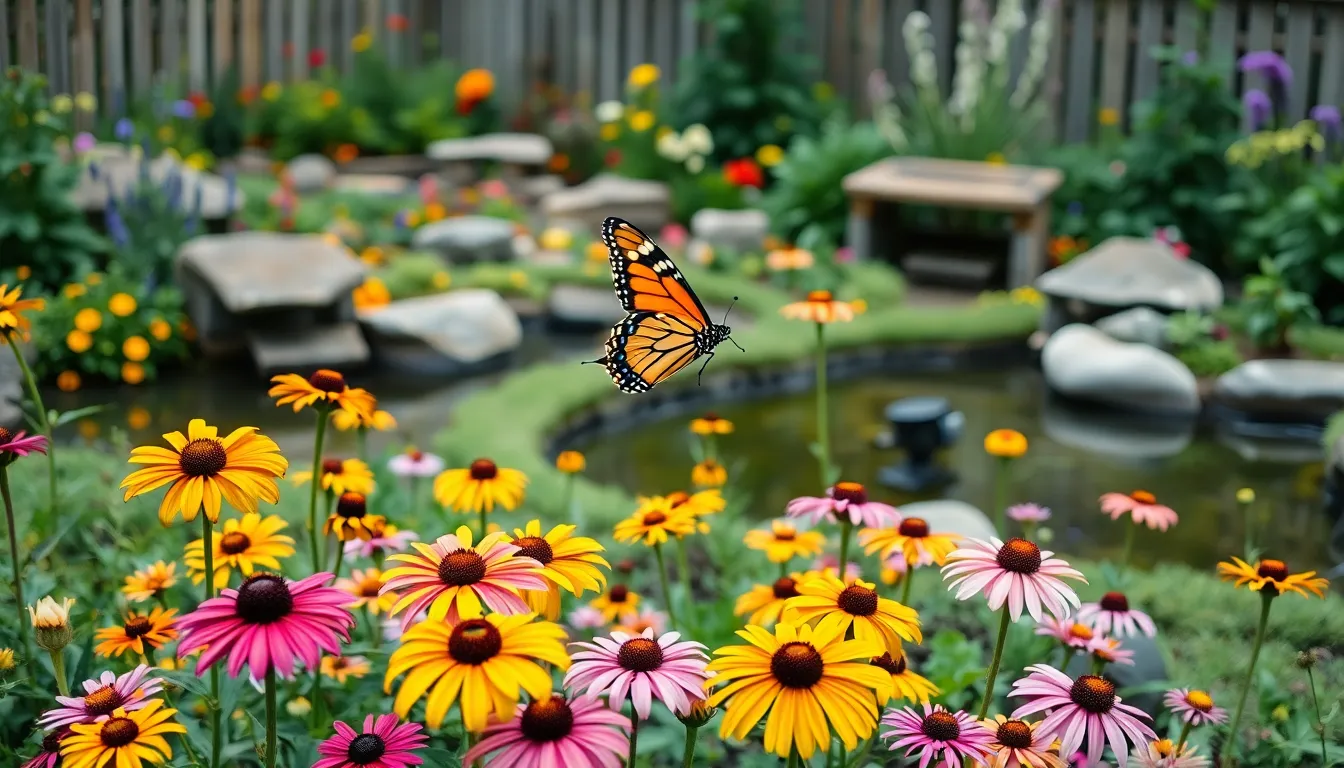
Creating a butterfly and pollinator friendly garden transforms our outdoor spaces into thriving ecosystems. We’ll build on our foundation of beautiful flower beds by adding purpose driven plants that support local wildlife.
Select Native Wildflowers and Local Plants
Native wildflowers form the cornerstone of any successful pollinator garden because they’ve evolved alongside local butterfly and bee populations. We recommend incorporating species that naturally occur in our region to ensure a reliable food source throughout the growing season.
Local plants require less water and maintenance compared to exotic varieties while providing essential nectar and pollen. Black eyed Susans and Bee Balm serve as excellent spring options that butterflies absolutely love. These hardy perennials establish quickly and spread naturally to create larger colonies over time.
Research shows that native plants support 50 times more butterfly and moth species than non native alternatives. We can contact our local extension office or native plant society to identify the best wildflower species for our exact area and soil conditions.
Create Bloom Succession Throughout the Seasons
Bloom succession ensures continuous nectar sources from early spring through late fall when pollinators need consistent food supplies. We’ll plant early blooming flowers like Crocus and Hyacinth to support the first butterflies emerging from winter dormancy.
Summer months demand robust bloomers such as Cosmos and Zinnias that can withstand heat while producing abundant flowers. Zinnias particularly excel in hot weather and bloom continuously until the first frost. Sunflowers add dramatic height and attract both butterflies and beneficial birds to our garden space.
Fall flowering plants like Asters and Goldenrod provide crucial late season nutrition for migrating butterflies and overwintering pollinators. These autumn bloomers help butterflies build energy reserves before winter or long migration journeys south.
| Season | Recommended Plants | Bloom Duration |
|---|---|---|
| Spring | Black-eyed Susans, Bee Balm, Crocus, Hyacinth | March – May |
| Summer | Zinnias, Sunflowers, Cosmos | June – August |
| Fall | Asters, Goldenrod, Sedum | September – November |
Add Water Features and Shelter Elements
Water features create essential drinking stations for butterflies and bees who need shallow water sources with landing spots. We’ll install shallow dishes filled with fresh water and add small stones or pebbles for safe landing areas.
Small ponds with gentle slopes allow pollinators to access water easily without drowning risk. Position water features near flower beds to create convenient rest stops during feeding activities. Change water regularly to prevent mosquito breeding and maintain clean drinking conditions.
Shelter elements provide protection from wind and predators while offering safe spaces for butterflies to rest and lay eggs. Rocks and logs create natural basking spots where butterflies can warm themselves in morning sunlight. Native grasses and shrubs form windbreaks that protect delicate butterfly wings from strong gusts.
Incorporate fallen branches and leaf litter in designated areas to support overwintering beneficial insects. These natural shelter materials house butterfly pupae and provide nesting sites for native bees throughout colder months.
Establish a Shade-Tolerant Flower Bed
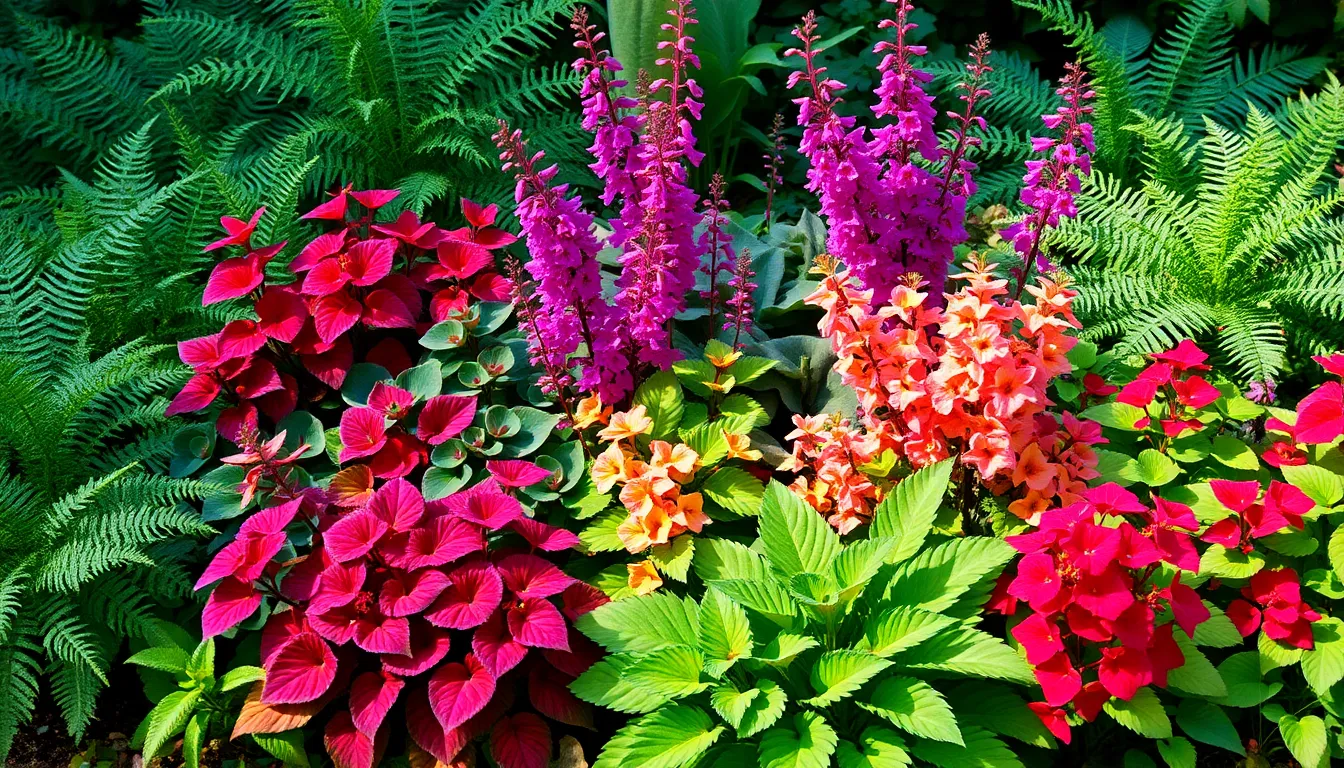
Shaded areas in our gardens present unique opportunities to create stunning flower displays that thrive away from direct sunlight. We’ll show you how to transform those challenging spots into vibrant, flourishing garden spaces.
Pick Flowering Plants That Thrive in Low Light
Coleus offers exceptional versatility for shaded flower beds with its vibrant, patterned foliage that grows well in partial to full shade. We can use these colorful specimens as striking accents in containers or as bold border elements throughout our garden design.
Coral Bells provide remarkable adaptability since these perennials thrive in both shade and sun conditions depending on the exact variety we choose. Their diverse foliage colors add incredible texture variation that enhances our overall garden composition year round.
Fuchsia delivers spectacular visual impact with its distinctive raindrop shaped flowers that make it a popular choice for shady garden beds. These vibrant blooms provide continuous color throughout the growing season in areas where other flowering plants struggle to perform.
Layer Plants by Height and Bloom Time
Strategic layering creates exceptional depth by positioning taller plants like shrubs or small trees in the back areas while placing shorter perennials and groundcovers toward the front. This arrangement generates visual interest that flows naturally throughout the entire growing season.
Varied bloom times ensure continuous color when we select plants that flower at different periods throughout the year. Our flower bed maintains constant visual appeal rather than experiencing gaps where no blooms are present.
Height variation maximizes garden impact as we combine different plant sizes to create a ever-changing industry that draws the eye upward and across the entire planting area. This technique transforms flat, boring spaces into captivating three dimensional garden displays.
Use Foliage Plants to Add Texture and Interest
Diverse foliage textures provide year round appeal by incorporating plants with varying leaf shapes, sizes, and surface qualities that maintain visual interest even during non flowering periods. We achieve depth and complexity through these carefully selected foliage combinations.
Ferns and hostas excel in shaded conditions while delivering the lush, verdant foliage that creates a rich foundation for our flower bed design. These shade tolerant plants add essential greenery and texture that complements flowering specimens beautifully.
Foliage color variations enhance garden sophistication as we combine plants with different leaf hues ranging from deep greens to silvery tones and variegated patterns. This approach creates subtle contrast that elevates our entire shade garden composition.
Create a Drought-Resistant Xerophytic Garden
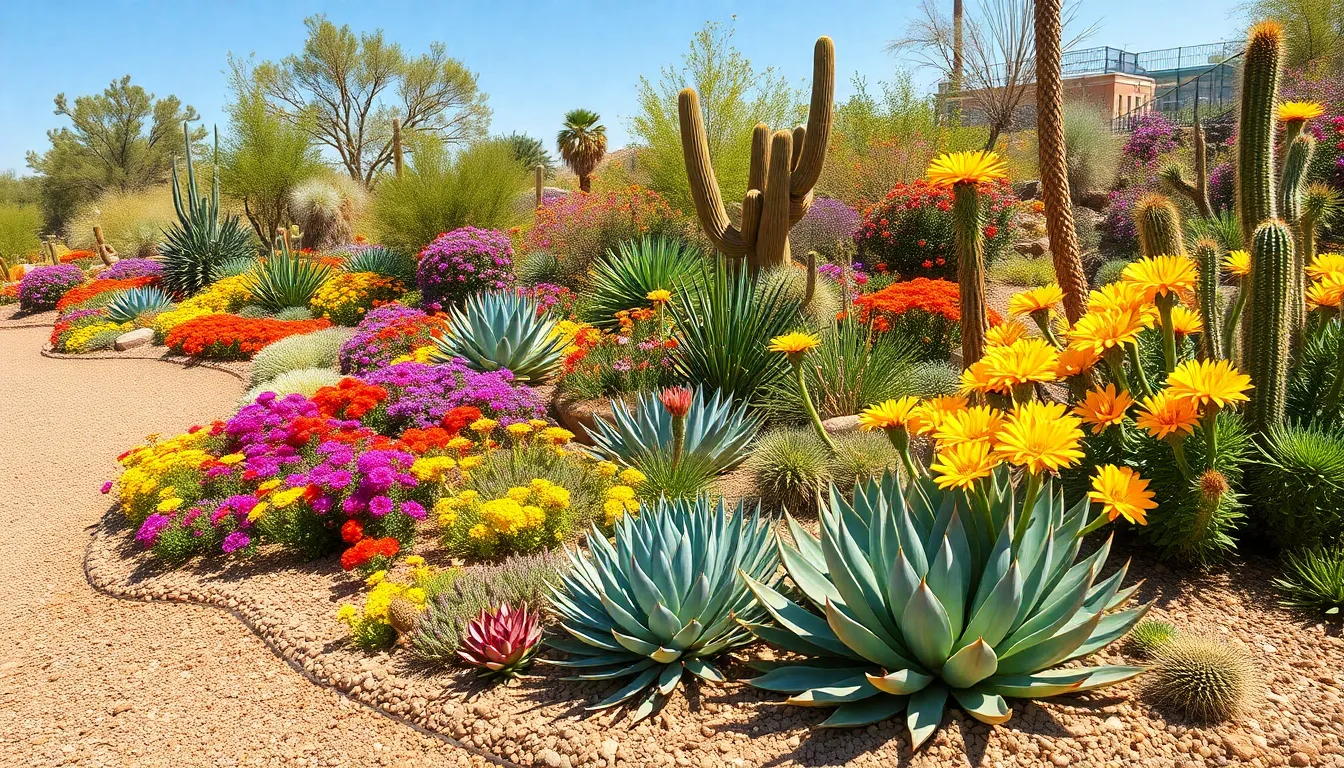
Transform your outdoor space into a water-wise sanctuary that thrives in arid conditions. We’ll show you how to design stunning flower beds that require minimal irrigation while maintaining year-round beauty.
Choose Succulents and Desert-Adapted Flowers
Succulent varieties like aloe, agave, and echeveria form the backbone of drought-resistant gardens. These hardy plants store water in their leaves and stems, making them exceptionally resilient during dry spells. Aloe species provide medicinal benefits alongside their sculptural appearance, while agave plants create dramatic focal points with their architectural forms.
Desert flowers such as desert marigold and lantana deliver vibrant colors without demanding constant watering. Desert marigold produces cheerful yellow blooms that persist through extreme heat, while lantana offers clusters of colorful flowers in shades of orange, red, yellow, and purple. These flowers attract butterflies and beneficial insects while requiring minimal maintenance.
Flowering cacti add unexpected beauty to xerophytic gardens with their spectacular blooms. Prickly pear cacti produce bright yellow or pink flowers, followed by edible fruits that wildlife enjoys. Barrel cacti showcase stunning crowns of yellow or red flowers during their blooming season.
Design with Gravel Mulch and Rock Features
Gravel mulch improves drainage while reducing water retention around plant roots. This natural covering prevents soil erosion and reflects heat away from plant bases, creating a cooler root zone. Choose locally sourced gravel in colors that complement your plant selections and home exterior.
Rock formations and boulders create visual interest while serving practical purposes in xerophytic gardens. Large rocks retain warmth during cool nights, protecting nearby plants from temperature fluctuations. Position boulders strategically to create natural windbreaks and microclimates for more sensitive plants.
Decomposed granite pathways connect different garden areas while maintaining the drought-resistant theme. This permeable material allows rainwater to infiltrate the soil rather than running off into storm drains. Decomposed granite also provides excellent drainage around plant roots.
Group Plants by Water Requirements
Water-efficient grouping ensures that plants with similar moisture needs grow together in designated zones. Place the most drought-tolerant plants in areas with maximum sun exposure and excellent drainage. Reserve slightly more water-dependent plants for areas with morning shade or improved soil conditions.
Drought-tolerant varieties should dominate your plant selection to minimize overall watering needs. Focus on native species that have adapted to your local climate conditions over thousands of years. These plants require less fertilizer, pest control, and irrigation than non-native alternatives.
Zone-appropriate selections guarantee long-term success in your xerophytic garden. Always choose plants rated for your local hardiness zone to ensure they’ll survive winter temperatures and summer heat. Consult your local extension office for recommendations on the best drought-resistant plants for your exact region.
Soil amendments with sand or other gritty materials improve drainage in areas with heavy clay soil. Test your soil’s drainage by digging a hole and filling it with water – if water remains after 24 hours, you’ll need to amend the soil or create raised planting areas for optimal plant health.
Design a Seasonal Color Theme Flower Bed

Creating a flower bed that evolves through the seasons ensures we’ll enjoy continuous color and interest throughout the year. We can achieve this stunning transformation by strategically planning plantings that peak during different times of the growing season.
Plan Spring Bulb Displays
Spring bulb displays kickstart our flower bed’s seasonal journey with vibrant early season color that emerges when winter begins to fade. Tulips, daffodils, and hyacinths provide the most popular options for creating these early spring showcases that announce the arrival of warmer weather.
Plant bulbs in clusters or distinct patterns rather than scattering them randomly throughout the bed to create maximum visual impact. Combining early and late blooming bulbs extends our color display from March through May, ensuring we capture the full beauty of spring’s awakening.
Group bulbs of the same variety in odd numbered clusters of 5, 7, or 9 specimens to create natural looking drifts that mimic how flowers grow in nature. Layer different bulb depths according to package instructions, typically planting larger bulbs like tulips 6-8 inches deep while smaller varieties like crocuses need only 3-4 inches of soil coverage.
Select Summer Heat-Tolerant Bloomers
Summer heat tolerant bloomers become essential for maintaining vibrant color when temperatures soar and other plants begin to wilt. Salvia, cornflower, and black-eyed Susans excel at withstanding intense summer conditions while producing abundant flowers that attract beneficial pollinators.
Create ever-changing layered effects by positioning taller specimens like sunflowers or ornamental grasses at the back of our flower bed. Mid height plants occupy the middle ground while shorter varieties fill the front border, establishing a cascading design that showcases every bloom.
Choose drought resistant varieties that thrive in full sun exposure and require minimal supplemental watering once established. Native summer bloomers often prove most successful because they’ve adapted to local climate conditions over thousands of years.
Water deeply but less frequently to encourage strong root development that helps plants survive periods of extreme heat. Mulch around summer bloomers with organic materials to retain soil moisture and keep root zones cooler during peak summer temperatures.
Include Fall Foliage and Late-Season Flowers
Fall foliage and late season flowers provide the grand finale for our seasonal flower bed design when most gardens begin their dormant phase. Asters, chrysanthemums, and sedum deliver vibrant autumn blooms in rich purples, golds, and deep reds that complement changing tree colors.
Incorporate foliage plants like coleus or sweet potato vines alongside flowering varieties to add textural interest and additional color depth. These foliage plants often display their most intense colors as temperatures cool, creating stunning contrasts with fall flowering specimens.
Mix deciduous shrubs with perennials to establish a ever-changing display that showcases multiple types of fall interest. Deciduous varieties contribute changing leaf colors while perennials provide structural elements that persist through winter months.
Plant fall bloomers in late summer to ensure they establish strong root systems before their peak flowering period arrives. Select varieties that complement our existing color scheme while introducing warmer autumn tones that celebrate the season’s natural palette.
| Season | Primary Plants | Peak Bloom Time | Special Features |
|---|---|---|---|
| Spring | Tulips, Daffodils, Hyacinths | March – May | Early color emergence |
| Summer | Salvia, Cornflower, Black-eyed Susans | June – August | Heat tolerance |
| Fall | Asters, Chrysanthemums, Sedum | September – November | Extended bloom period |
Install an Edible Flower Garden Bed

Transform your outdoor space into a functional culinary paradise that combines beauty with flavor. An edible flower garden bed brings both visual appeal and fresh ingredients directly to your kitchen.
Grow Culinary Flowers for Cooking and Garnishing
Nasturtiums stand out as the perfect starter flowers for culinary gardens, delivering a distinctive peppery kick that transforms ordinary salads into gourmet experiences. These vibrant blooms thrive in herb gardens and require minimal maintenance while providing continuous harvests throughout the growing season.
Borage flowers offer a refreshing cucumber-like flavor that complements fruits, salads, and summer beverages perfectly. Plant these blue star-shaped blossoms in full sun areas where they’ll self-seed and return year after year with minimal effort from gardeners.
Calendula petals, also known as pot marigold, bring spicy to tangy notes that enhance pasta dishes and herb butters magnificently. We recommend harvesting the outer petals regularly to encourage continued blooming and maintain peak flavor intensity.
Pansies provide delicate sweetness that makes them ideal for decorating cakes and creating stunning floral arrangements. These cool-weather flowers bloom best in spring and fall, offering versatility for both sweet and savory culinary applications.
Violets serve dual purposes as attractive ground cover and edible garnishes for salads and drinks. Their mild, sweet flavor makes them particularly appealing to children and guests who might be hesitant about eating flowers.
Combine Herbs with Edible Blooms
Basil flowers complement their parent plants by adding subtle floral notes to soups and salads while extending the harvest season. Allow some basil plants to flower naturally to enjoy these tiny white or purple edible blossoms that taste like concentrated basil essence.
Oregano blooms attract beneficial pollinators while providing edible flowers that carry the herb’s signature Mediterranean flavor. We suggest leaving some oregano plants unharvested to encourage flowering and support local bee populations.
Rosemary flowers offer the same aromatic qualities as their needle-like leaves, making them excellent additions to Mediterranean dishes and herb-crusted proteins. These small blue, white, or pink flowers appear in spring and can be used fresh or dried for year-round culinary applications.
Integrate these herb flowers strategically throughout your edible garden bed to create natural pest control while maximizing both visual appeal and culinary diversity.
Plan Harvest Timing for Continuous Supply
Staggered planting ensures consistent flower production throughout the growing season, with most edible blooms reaching peak harvest during summer months. Start new plantings every 2-3 weeks to maintain steady supplies for kitchen use and prevent overwhelming harvests.
Morning harvesting provides the best flavor and longest vase life for edible flowers, as plants contain maximum moisture and essential oils before the day’s heat sets in. We recommend cutting flowers just after dew has dried but before temperatures rise above 70°F.
Quick succession plantings of fast-growing annuals like nasturtiums and calendulas extend your harvest window from spring through first frost. Plant cool-season flowers like pansies and violets in early spring and again in late summer for extended availability.
Store harvested edible flowers in the refrigerator between damp paper towels for up to one week, though we encourage using them within 24-48 hours for optimal flavor and appearance.
Conclusion
We’ve explored countless ways to transform your outdoor space into a stunning floral showcase that reflects your personal style and meets your garden’s unique needs. Whether you’re drawn to the romantic charm of cottage gardens or the sleek sophistication of modern minimalist designs each approach offers its own rewards and beauty.
The key to success lies in understanding your space and choosing plants that thrive in your exact conditions. From drought-resistant xerophytic gardens to lush shade plantings there’s a perfect solution for every corner of your property.
Remember that great flower beds don’t happen overnight but evolve with careful planning and thoughtful plant selection. Start with one inspiring design that speaks to you and watch as your garden transforms into the beautiful outdoor sanctuary you’ve always envisioned.
Frequently Asked Questions
What’s the ideal ratio of annuals to perennials in a cottage garden?
For a cottage garden that maintains year-round interest, aim for 60% perennials and 40% annuals. This ratio ensures a stable foundation of returning plants while allowing seasonal color changes through annuals. Perennials provide structure and reliability, while annuals offer flexibility to experiment with different colors and varieties each growing season.
How do I choose the right materials for raised flower beds?
Select materials based on your climate conditions. Wood works best in dry areas, while stone or brick are ideal for moisture-prone environments due to their durability. For low-maintenance options, consider recycled plastic or composite materials. These alternatives resist rot and require minimal upkeep while providing excellent structural support for your plants.
Which plants work best for shaded flower beds?
Shade-tolerant plants like Coleus, Coral Bells, and Fuchsia thrive in low-light conditions while providing vibrant colors. Incorporate foliage plants such as ferns and hostas for texture and year-round appeal. Use strategic layering by height and bloom time to create depth and ensure continuous visual interest throughout the growing season.
How can I create a drought-resistant flower garden?
Focus on succulents and desert-adapted flowers like aloe, agave, and desert marigold that require minimal watering. Use gravel mulch and rock features to improve drainage and visual appeal. Group plants by water requirements and select native species suited to your local climate for long-term success with minimal maintenance.
What are the best flowers for attracting butterflies and pollinators?
Plant native wildflowers like black-eyed Susans and Bee Balm for essential nectar sources. Plan for bloom succession with early bloomers (Crocus, Hyacinth), summer flowers (Zinnias, Sunflowers), and fall varieties (Asters, Goldenrod). Include water features and shelter elements like rocks to create a complete habitat for pollinators.
Which flowers are safe to eat and easy to grow?
Nasturtiums, borage, calendula, pansies, and violets are excellent edible flowers for beginners. They’re safe to consume and add beautiful colors to salads and dishes. Include herb flowers like basil, oregano, and rosemary for dual culinary and pest control benefits. Practice staggered planting for continuous harvests throughout the season.
How do I design a modern minimalist flower bed?
Focus on three key principles: use a monochromatic color scheme for visual impact, create geometric planting patterns for rhythm, and incorporate ornamental grasses for texture. Use neutral mulches to complement your color palette and plant in precise arrangements. Add strategic statement plants to enhance the clean, architectural aesthetic.
What’s the best soil mix for raised flower beds?
Create a balanced mix of topsoil, aged compost, and perlite or vermiculite for optimal drainage and plant health. This combination provides nutrients, improves soil structure, and prevents waterlogging. Ensure proper soil depth based on your plant selections, with most flowers requiring at least 6-8 inches of quality growing medium.

